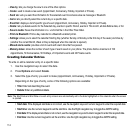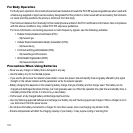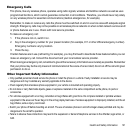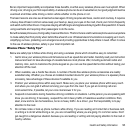118
For Body Operation
For body worn operation, this model phone has been tested and meets the FCC RF exposure guidelines when used with
a Samsung-supplied or approved accessory designated for this product or when used with an accessory that contains
no metal and that positions the phone a minimum from the body.
The minimum distance from the body for this model phone is written in the FCC certification information. Non-compliance
with the above conditions may violate FCC RF exposure guidelines.
For more Information concerning exposure to radio frequency signals, see the following websites:
•
Federal Communications Commission (FCC)
–
http://www.fcc.gov
•
Cellular Telecommunications Industry Association (CTIA):
–
http://www.ctia.org
•
U.S.Food and Drug Administration (FDA)
–
http://www.fda.gov/cdrh/consumer
•
World Health Organization (WHO)
–
http://www.who.int/peh-emf/en
Precautions When Using Batteries
•
Never use any charger or battery that is damaged in any way.
•
Use the battery only for its intended purpose.
•
If you use the phone near the network’s base station, it uses less power; talk and standby time are greatly affected by the signal
strength on the cellular network and the parameters set by the network operator.
•
Battery charging time depends on the remaining battery charge, the type of battery and the charger used. The battery can be
charged and discharged hundreds of times, but it will gradually wear out. When the operation time (talk time and standby time) is
noticeably shorter than normal, it is time to buy a new battery.
•
If left unused, a fully charged battery will discharge itself over time.
•
Use only Samsung-approved batteries and recharge your battery only with Samsung-approved chargers. When a charger is not in
use, disconnect it from the power source.
•
Do not leave the battery connected to a charger for more than a week, since overcharging may shorten its life.
•
Extreme temperatures will affect the charging capacity of your battery: it may require cooling or warming first.


















